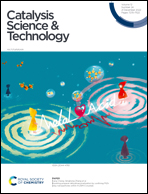Synergistic effect of biomass-derived carbon decoration and nitrogen defects on seaweed-like tubular g-C3N4 for enhanced photocatalytic H2 evolution†
Abstract
Developing efficient and low-cost g-C3N4 for photocatalytic H2 evolution has received considerable attention in solar energy utilization. Herein, biomass-derived carbon modified nitrogen deficient seaweed-like tubular g-C3N4 (C/D–CN) was obtained by facile thermal polymerization of a freeze-dried sodium alginate, KOH and urea mixture precursor. Sodium alginate induced the formation of a tubular morphology and converted into a carbon material in situ decorating g-C3N4, while KOH played a role in regulating nitrogen defects. Thanks to the improved light absorption, increased electrical conductivity and accelerated separation and transfer of photogenerated carriers under the synergistic effect of carbon decoration and nitrogen defects, C/D–CN exhibits a notably enhanced H2 evolution rate (HER) of 4123 μmol h−1 g−1, which is 2.8, 4.4 and 36.9 times that of carbon modified g-C3N4, nitrogen deficient g-C3N4 and bulk g-C3N4, respectively. This work highlights a feasible strategy for developing an efficient photocatalyst from the synergistic effect of reasonable multiple modification methods.



 Please wait while we load your content...
Please wait while we load your content...